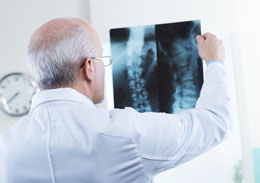Osteosarcoma is a type of bone cancer that affects the osteoblasts, the bone cells from where the bone tissues develop. This bone cancer often manifests in pain and swelling of the affected bones and joints. Find out some more symptoms of osteosarcoma, in this Buzzle article.

Osteosarcoma is a common type of bone cancer that mostly affects children and teenagers, especially those under the age of 15 years. This cancer is also observed to be more common in young and teenage boys than girls. The cancer affects the bone cells, known as osteoblasts from where bones develop.
However, it can eventually spread or metastasize to other parts of the skeletal system, if not diagnosed and treated on time. Hence, a proper knowledge about its signs and symptoms is crucial for identifying the disease in the early stage. So, here is a brief discussion about the causes, symptoms, and treatment of osteosarcoma.
Causes of Osteosarcoma
Despite a large number of research and studies carried out on osteosarcoma, the exact causes of the disease are not known. It is believed that the cancer can be triggered by an overactivity of the bone cells due to an error in their DNA. As a result, the immature bone cells can become malignant, and fail to develop into mature bones.
Such a genetic mutation can be brought about by the exposure to radiation. Therefore, children who receive radiation therapy as a part of cancer treatment, are considered to have an increased risk of developing osteosarcoma. Even an exposure to radiation emitted from elements like radium and fluoride is considered a risk factor for this type of cancer. Apart from these, osteosarcoma in a few cases has been observed to run in families. It has been found to have an association with the disease retinoblastoma as well.
Signs and Symptoms
Osteosarcoma has been usually found to affect the bones of the shin, upper arm, and thigh. The usual symptoms produced by this cancer are pain and swelling. However, the symptoms can vary, depending on the location or the particular bone that is affected. The most commonly observed signs and symptoms are:
- Pain in the affected bones and joints
- Swelling and tenderness of the affected area
- Bone or joint stiffness
- Bone fracture
- Fever
- Excessive fatigue or tiredness
- Unexplained weight loss
- Anemia
Diagnosis and Treatment
Usually, diagnosis of osteosarcoma begins with a detailed study of the patient's medical history, physical examinations, X-ray of the bones, and MRI of the affected area. Bone scans, blood tests, CT scan, and bone biopsy are also carried out to make a confirmed diagnosis, and to see if the cancer has spread to other part of the body.
Osteosarcoma is usually treated with chemotherapy and surgical resection. The most commonly used chemotherapy drugs for treating this cancer are, cisplatin, doxorubicin, carboplatin, methotrexate, and ifosfamide. These medications are used to either shrink or destroy the cancerous bone cells. Chemotherapy is followed by surgery to remove the tumors. The most commonly performed surgical procedures are, limb-salvage surgery or amputation. Amputation is carried out only when the cancer has already spread to the surrounding blood vessels and nerves.
Presently, research and studies are going on to develop more treatment options for this bone cancer. The prognosis of this cancer depends primarily on the stage in which it is detected, and whether the tumor is localized or metastatic. If detected in the early stage, the prognosis is quite good. To ensure early diagnosis and prompt treatment of the condition, it is crucial to identify the symptoms on time. Therefore, any kind of pain and swelling of the bones and joints should be evaluated properly, in order to prevent the complications that can arise from osteosarcoma.
Disclaimer:
This article is for informative purposes only, and should not be treated as a substitute for professional medical advice.


 Osteosarcoma is a common type of bone cancer that mostly affects children and teenagers, especially those under the age of 15 years. This cancer is also observed to be more common in young and teenage boys than girls. The cancer affects the bone cells, known as osteoblasts from where bones develop.
Osteosarcoma is a common type of bone cancer that mostly affects children and teenagers, especially those under the age of 15 years. This cancer is also observed to be more common in young and teenage boys than girls. The cancer affects the bone cells, known as osteoblasts from where bones develop.